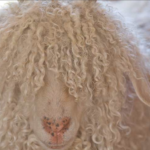Mohair is definitely having a moment as we keep finding ourselves adding new mohair patterns from some of our favourite designers to our Ravelry queues. Often referred to as the diamond fibre for it’s lustre and durability, we thought we’d have a look at the history of the fibre and the breed behind it; Angora goats.
History
Using goat hair for clothing is an ancient practice and there are records as early as the 14th Century BC of goat hair, probably from the Angora breed, being used in this way. Angora goats are believed to have originated from the Himalaya Mountains of Asia. In the early 13th Century AD there are records that these goats were trekked thousands of miles by Suleiman Shah when fleeing from Ghengis Khan. They fled to Angora in Asia Minor where the breed thrived, and it is thought that this is how the Angoras acquired their name. This region is now known as Ankara, the capital of Turkey and Turkey remains one of the leading mohair suppliers today. The Angora fleece acquired the name Mohair from the Arabic word Mukhaya which means ‘cloth of bright lustrous goat hair’.
The distinctive properties of mohair have made it a highly desired fibre for enhancing both clothing and home furnishings. Throughout the centuries there have been many attempts to import Angoras across the globe, including a number of unsuccessful attempts to bring Angoras to Europe. The first attempt was in 1554 by Charles V, then another in 1765 by the Spanish government. In the 1780’s a larger group were imported into France, though none of these were successful in establishing mohair production. The Angoras were however successfully imported to South Africa where they thrived and still thrive there today.
Over the centuries Angoras were crossed with other breeds, widening the gene pool. In the 1980s larger numbers of goats were successfully imported to the UK from Australasia and British Angora is now well established, having adapted to the different climate while the quality of the mohair they produce has improved.
Angora Goats
Angoras are thought to be very picturesque. They are small compared to common goats, bucks reaching a maximum weight of 225 pounds, while mature does can weigh up to 110 pounds. Both bucks and does have horns, the bucks usually having a pronounced spiral to the horn while the females horns are comparatively short and straight.
They are good foragers and can graze well on areas where sheep would not do well, due to their ability to stand on their hind legs and eat what they can reach by doing so. However keeping angoras has its challenges as they are amongst the most delicate of the domesticated animals, especially at birth. Their young require extra protection and care in the first few days if the weather is cold or damp. In fact even the adults do not do well with cold wet rains immediately after shearing.

Angora fleece
Angoras are classified according to the type of hair they grow. There are two types, ringlet type goats and flat lock goats. The former are often referred to as C Type and produce the finest mohair being carried in tight ringlets. The mohair from B Type goats is more bulky and wavy in appearance.
The average Angora goat is sheared twice and year and produces approximately 5.3 pounds per shearing. The mohair is graded by type; kid, young goat and adult and then by length and style. Correct shearing is very important to ensure that very short fibres are avoided. Ideally the fleece length should be as uniform as possible and care should be taken to prevent contamination from stained fibre, hay or straw which all downgrade the value of the fleece. Interestingly, the market valuation of mohair fluctuates more than for wool.
The fibre produced has a staple length of between 12 and 15 cm. It is similar to wool in chemical composition but differs in that it is uncrimped and has a very thin, smooth scale. This very smooth surface means that it cannot be felted like wool but it is elastic and has considerable lustre. Mohair is luxuriously soft and lustrous and has an excellent affinity for dyes, producing yarns and fabric with an unmatched clarity, intensity and halo- like glow. It is also strong, durable and hard wearing. Mohair fabrics wear well as they won’t mat or pill. Dust and dirt can be easily brushed off and bacteria cannot become trapped in its smooth scales. Mohair fabric is also insulating and breathable and can be worn throughout the seasons. These desirable properties have made mohair incredibly popular throughout the centuries for use in both clothing and luxury textiles.
Mohair for knitting
Looking back at how the mohair was was used to enhance fabrics through the centuries, it is interesting that this has come full circle in our knitting today. In recent months, there have been a whole host of new pattern releases using mohair held double with another fibre thus enhancing the fabric produced with its desirable properties. You can find a round up of some of our favourites here. We recently welcomed Onion’s Silk & Kid Mohair to our shelves at YAK. We love this particular mohair for it’s gorgeous rich colour palette and for it’s high silk content which accentuates that beautiful halo-like glow. Being lace weight it’s perfect for holding double with another yarn to enhance the knitted fabric produced.
SOURCES
http://afs.okstate.edu/breeds/goats/angora/index.html/
https://www.angoragoats-mohair.org.uk/mohair-fibre/
https://www.thenaturalfibre.co.uk/mohair/
https://www.britishgoatsociety.com/about-us/breeds/angora/
IMAGES
http://www.mohairandmore.com/angora_goats/images/








 No products in the basket.
No products in the basket.